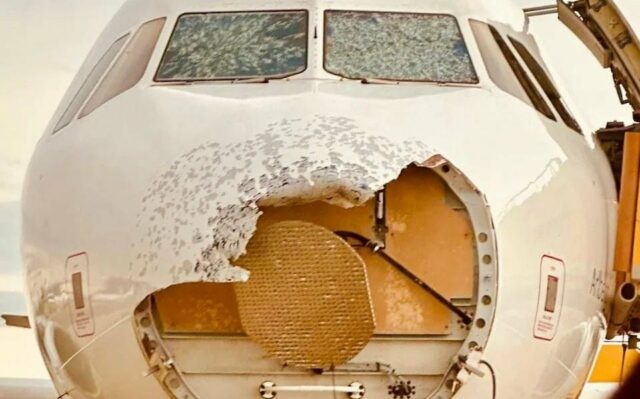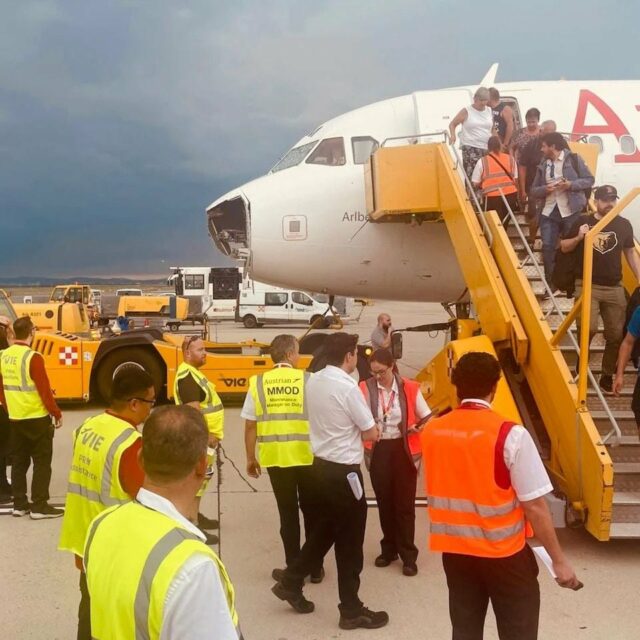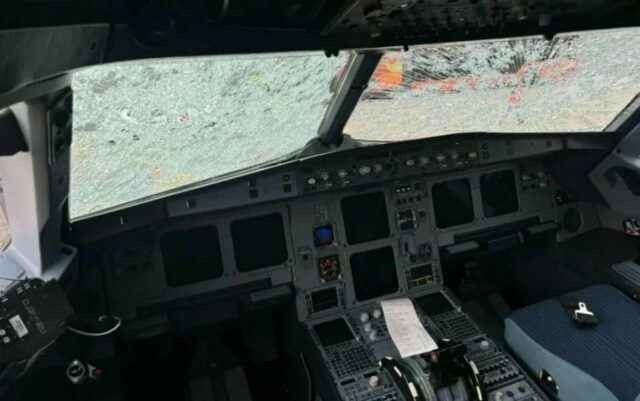Hail Damage to Austrian Airlines A320
I’ve been intrigued by the photographs being passed around of the Austrian Airlines Airbus A320 that flew into a hailstorm. We’ve seen some hail-battered planes before but this one took the nose cone right off!
Austrian Airlines, a subsidiary of Lufthansa, is the flag carrier of Austria. They ordered four new Airbus A320neo aircraft in 2022. This aircraft, registered as OE-LBM, was thankfully not one of the new A320s but an A320-214 manufactured in 2013 and given the name Arlberg. Here is what Alberg’s nose looks like on a good day.

And here is Arlberg after the storm.

It was Sunday, the 9th of June 2024, and Arlberg was flying Austrian Airlines flight 434 from Palma de Mallorca, Spain, back home to Vienna. There were 173 passengers and 6 crew on board. The flight seemed routine until the flight crew started the final descent from 34,000 feet. At about 60 nautical miles from Vienna, passing through FL200 (20,000 feet), the aircraft entered a thunderstorm cell. The nose/radome and the windshields broke under the pressure of the driving hail and the flight crew quickly called an emergency as they continued to Vienna.
They landed safely at Vienna. There were no injuries other than poor Arlberg.

A representative of Austrian Airlines said on Austrian television that the thunderstorm cell was not visible on the aircraft’s weather radar. The limitations of weather radar came up in the discussion about the extreme turbulence suffered by Singapore Airlines flight SQ321. Specifically, that weather radar struggles with very cold/icy storms. It is fine at spotting “wet hail” but if the conditions are cold enough, then the dry hail will not appear on the radar system, thus, it is easy to have flown straight into the storm before you know what happens. This has come up as a possible reason as to why the thunderstorm cell did not appear, especially as the eleven-year-old aircraft is said to still be equipped with older radar systems.
Austrian Wings, an Austrian aviation magazine, describes the scene (translation mine).
Without warning, the Airbus A320 entered a hailstorm and was violently shaking. But not just that. While the aircraft was flying at a ground speed of 453 knots (about 840 kilometers per hour), countless hailstones battered the fuselage, engines, and cockpit windows. Although the hail did not penetrate the multi-layered cockpit windows (which would have led to a loss of pressure and possibly serious injuries to the pilots), the cockpit windows were so damaged that the flight crew became “blind.” Additionally, the noise level must have been enormous from one second to the next. A high psychological strain for the crew. At the same time, the hail’s force shredded the cover of the weather radar located in the nose and eventually tore it off the fuselage. The engine pylon fairings, the leading edge of the wings, and other parts of the aircraft were also severely damaged by the force of the hailstones, which were up to 4 centimeters in size.
A passenger told ABC News that they could “feel the hail” as it smashed into the plane. Another passenger saw something fly past his window and only realised after landing that what he’d seen was parts of the nose cone.

According to Aviation Herald, the airline suspended the crew for seven days.
A meteorologist from Austrocontrol, who supply air traffic control in Austrian airspace, has claimed that the thunderstorm cell was visible and pilots had been warned of the dangerous weather conditions. Krzysztof Piasecki, who studies radar detection of supercell storms, also expressed that the strong supercell must have been visible on radar.
Further confusing the matter, there are a number of unsubstantiated comments online that the first officer was alone on the flight deck when the aircraft flew into the storm; however, there is no official statement by the airline regarding the situation.
The case is now being investigated by the Sicherheitsuntersuchungsstelle des Bundes (SUB), the Austrian safety investigation authority. Their report will clarify many of these issues. Key to the investigation will be whether the storm cell was visible on radar and whether the pilots had the opportunity to divert around the storm.
Two of the passengers on the flight have asked for a criminal investigation into negligent endangerment.
In an amusing side note, Austrian cable news channel OE24.TV reported that the storm tore off the propeller of the Airbus A320!!!1! and has been the brunt of many social media jokes ever since.
Inexplicably, none of the media have reported on how Arlberg is doing and the A320 has made no public appearances since arriving in Vienna. Austrian Wings wrote that a repair may not be economically feasible or sensible.










I wouldn’t be surprised to hear that the aircraft is quietly retired; I don’t know how much inspection (or even stress testing) would be enough to be sure that hailstone impacts hadn’t weakened any forward-facing struts.
Do we know whether the plane made a Cat III landing? (Wikipedia says this capability was planned for a planned third runway that doesn’t exist yet.) If not, I’m wondering how the pilots got the plane down safely with no full-forward visibility; they may have done well to get the plane down in one piece.
I hope there’s a full hearing on this; after the William Glen Stewart case, I’m suspicious of an airline that jumps to suspend pilots before there’s clear evidence — e.g., did they actually confirm the rumor that the captain wasn’t in the cockpit?
“A meteorologist from Austrocontrol” sounds like Monday-morning quarterbacking. I’m pretty certain that’s info that was not available to ATC or the air crew. He’s just a smug git.
At least in the US, there’s a lot of radar and other information that is very hard to dig up, and I’ll bet in Europe, finding out about stuff over the border is even harder.
I ride a motorcycle in Florida and trying to just find out if it’s raining or not on the way home is like pulling teeth. All the phone apps and websites are complete and utter dog bollocks, especially since stuff like PYKL3 was forced off Google Play.
Usually by the time radar gets to me, it’s been data processed into useless trash.
And as a matter of fact, I have a scar above my right collarbone from hail. It hit hard enough to drive a piece of leather jacket under the skin that a nurse had to remove a couple years later.
At CCSFS family day, I got a tour of the Space Force weather center they use for watching the weather for launches. Oh. My. God. Most of my questions were answered with “sorry, can’t say”
Obviously most of the radome was removed when the hail managed to perforate it enough to admit the 300Kt relative wind which then popped the fiberglass hemisphere like a party balloon.
I note that once the dome was gone the hail quickly reduced the antenna to junk. It almost looks deliberate.
My mind is filled with a fantasy story where violent weather cells have come to possess a sort of brute intelligence. They realize that the reason they aren’t killing as many aircraft as in former years is that the thing on a plane’s nose, that they thought was just to sting and annoy thunderstorms, is actually how planes see them. If planes didn’t have whatever is in that dome, they would become vulnerable again.
Through trial and error, they doped out that the icier a storm is, the harder it is for planes to see it. Wet storms, especially the most violent, usually miss their prey because they are too visible. So the weather cells held a meeting, and hatched a plan of action: Choose a brave volunteer hailstorm and assign him the dangerous mission to pounce on a plane, rip off the nose cover, and wreck whatever is inside it.
The destruction of Arlberg’s antenna is a big step forward for stormkind.